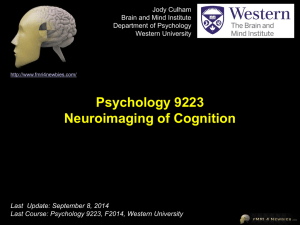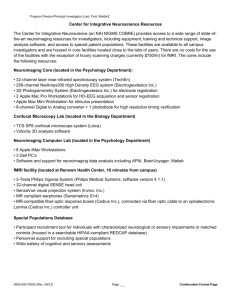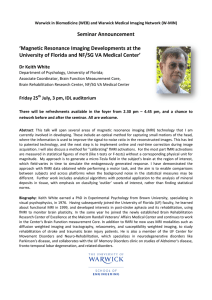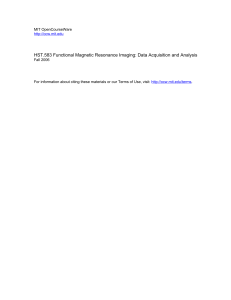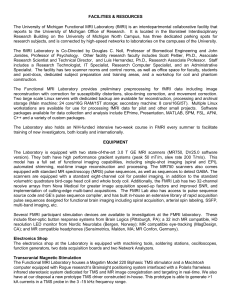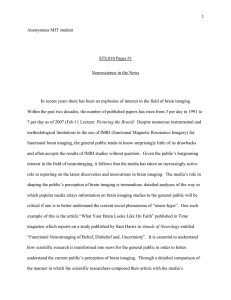Large-scale automated synthesis of human functional neuroimaging data.
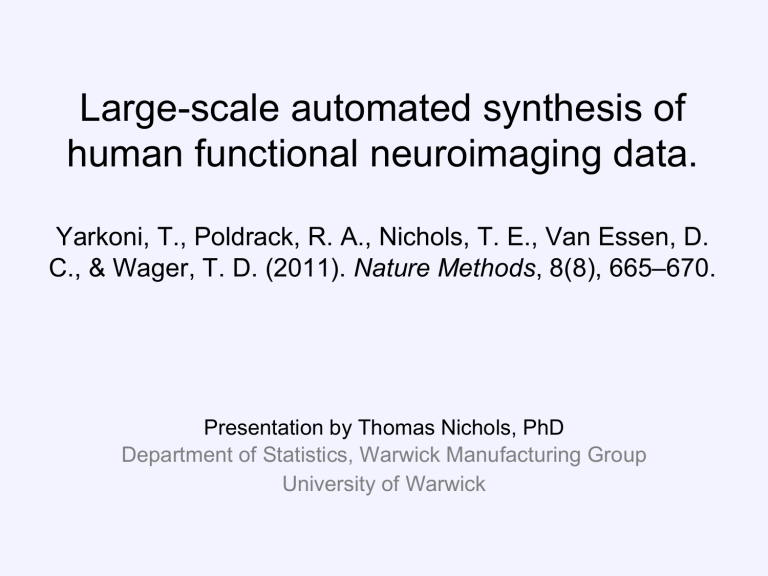
Large-scale automated synthesis of human functional neuroimaging data.
Yarkoni, T., Poldrack, R. A., Nichols, T. E., Van Essen, D.
C., & Wager, T. D. (2011). Nature Methods , 8(8), 665–670.
Presentation by Thomas Nichols, PhD
Department of Statistics, Warwick Manufacturing Group
University of Warwick
Understanding the Brain with Functional
Neuroimaging
• ~20 years of “functional neuroimaging”
– Functional Magnetic
Resonance Imaging
(fMRI)
– Measures changes in blood flow
• Cognitive Neuroscience
– Correlating brain activity with cognition, behavior, emotion, pain, etc.
– “Brain Mapping” fMRI http://www.ccbi.cmu.edu/
Single fMRI Image fMRI Time Series
Meta-Analysis for Brain Imaging
• Meta-Analysis
– Integration of results from multiple studies
• To increase power from pooling studies
• To discover which results generalize, which are idiosyncratic
• fMRI – an explosion of studies
– 2 papers in 1993 → 2446 papers in 2010
– Sample sizes small (10-20 subjects)
• Great need for fMRI meta-analysis
– But several challenges …
Imaging Meta-Analysis
fMRI:
3D Image Results...
• Authors don’t share their image data
• Only coordinates available
– x,y,z peaks of activation maps
• In standard brain atlas coordinates
• Meta-analysis
– x,y,z peak manually collected from papers x, y, z atlas coordinates
Results Table of Coordinates
Standard reporting format for a fMRI publication
Imaging Meta-Analysis: Problem
• Manual ‘harvesting of points’
– x,y,z peak manually collected from papers
– Topic of paper manually scored
–
• Vision study? Emotion study? Memory study?
Prone to error, limits number of studies x, y, z atlas considered coordinates
Results Table of Coordinates
Standard reporting format for a fMRI publication
“Neurosynth” – automated neuroimaging meta-anlaysis
• Uses HTML versions of published papers
• From each paper …
– Extracts x,y,z coordinates
– Records word frequency
• Occurrence per 1000 words
– e.g. “pain” occurs 6 times per 1000 words
• Then can relate locations to topics
– e.g. does a given brain area associate more with “pain” or “memory”?
Key Details
• Data sample
– 17 journals
– 3,489 articles
– 100,953 x,y,z coordinate locations
– 10,000 words
Key Details
• For study i
– Brain activation present
(w/in 10 mm)
or not
A ij
∈ {0,1} at voxel j
– For term k present
(> 1 in 1000 words)
or not
T ik
∈ {0,1}
• P( A | T k
=1) gives “forward inference”
– Probability of activation in studies with term k
Key Details
• P( T k
=1|A) gives “reverse inference”
– Given a new study with activation A, predict term k associated with study
– Naïve Bayes
• Independence assumed between brain voxels
– “Smoothing” used – add one “hit”, one “miss”
• Corresponds to Bernoulli MAP estimator
Key Results
• Forward & Reverse
Inferences
– Some areas weakly associated (forward), but highly specific
(reverse)
– Some areas strongly associated (forward), but not specific
(reverse)
Forward Inference
Term:
“pain”
Reverse Inference
Key Results
• Pairwise term classification
– Based on coordinate data
• “pain” most different
• “Attention” &
“Interference” very similar
Limitations
• Coordinate harvesting imperfect
– Difficult to parse all HTML tables
• Terms are not true “topics”
– An author can use many terms not directly about their own experiment
• Naïve Bayes
– Voxels clearly dependent
Conclusions
• Automated neuroimaging meta-analysis
• Applies text-mining and classification techniques, to …
– Speed and automate data collection
– Provide “reverse” inferences
– Explore relationship between different terms in literature
• On line tool
– http://www.neurosynth.org
